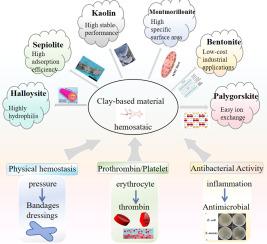粘土基止血剂:制造、机制和证据
IF 6
2区 医学
Q2 MATERIALS SCIENCE, BIOMATERIALS
Materials Science & Engineering C-Materials for Biological Applications
Pub Date : 2025-08-26
DOI:10.1016/j.bioadv.2025.214473
引用次数: 0
摘要
在急诊医学和战斗创伤管理中,出血控制仍然是一个严重的问题,实现快速止血显著影响患者的生存结果。虽然包括直接手动按压和止血带应用在内的传统干预措施在常规情况下显示出临床疗效,但在处理灾难性出血或解剖复杂的损伤时,它们的局限性变得明显。矿物为基础的止血剂,特别是粘土衍生的快速止血剂,已经成为一种有前途的治疗方式,它将祖先的伤口管理实践与当代材料工程相结合。这些铝硅酸盐化合物利用固有的阳离子交换能力和表面电荷特性,增强了生理混凝级联反应。这篇全面的综述系统地检查了现代粘土基止血剂的制造方法、分子止血机制和临床应用。通过对其晶体结构、理化性质和循证止血性能指标的批判性分析,我们建立了一个科学的框架,以优化急诊护理中粘土材料的部署。此外,这项工作为材料科学家通过纳米级修饰和协同生物材料集成来追求先进的复合止血系统提供了实质性的参考。本文章由计算机程序翻译,如有差异,请以英文原文为准。

Clay-based hemostatic agents: Fabrication, mechanisms, and evidence
Hemorrhagic control remains a serious concern in emergency medicine and combat trauma management, where achieving rapid hemostasis significantly impacts patient survival outcomes. While conventional interventions including direct manual compression and tourniquet application demonstrate clinical efficacy in routine scenarios, their limitations become apparent when managing catastrophic hemorrhage or anatomically complex injuries. Mineral-based hemostatic agents, particularly clay-derived rapid hemostats, have emerged as a promising therapeutic modality that synergizes ancestral wound management practices with contemporary material engineering. These aluminosilicate compounds capitalize on inherent cation-exchange capacities and surface charge characteristics that potentiate physiological coagulation cascades. This comprehensive review systematically examines the fabrication methodologies, molecular hemostatic mechanisms, and clinical applications of modern clay-based hemostatic agents. Through critical analysis of their crystalline structures, physicochemical properties, and evidence-based hemostatic performance metrics, we establish a scientific framework for optimizing clay material deployment in emergency care. Furthermore, this work provides substantive references for materials scientists pursuing advanced composite hemostatic systems through nanoscale modifications and synergistic biomaterial integrations.
求助全文
通过发布文献求助,成功后即可免费获取论文全文。
去求助
来源期刊
CiteScore
17.80
自引率
0.00%
发文量
501
审稿时长
27 days
期刊介绍:
Biomaterials Advances, previously known as Materials Science and Engineering: C-Materials for Biological Applications (P-ISSN: 0928-4931, E-ISSN: 1873-0191). Includes topics at the interface of the biomedical sciences and materials engineering. These topics include:
• Bioinspired and biomimetic materials for medical applications
• Materials of biological origin for medical applications
• Materials for "active" medical applications
• Self-assembling and self-healing materials for medical applications
• "Smart" (i.e., stimulus-response) materials for medical applications
• Ceramic, metallic, polymeric, and composite materials for medical applications
• Materials for in vivo sensing
• Materials for in vivo imaging
• Materials for delivery of pharmacologic agents and vaccines
• Novel approaches for characterizing and modeling materials for medical applications
Manuscripts on biological topics without a materials science component, or manuscripts on materials science without biological applications, will not be considered for publication in Materials Science and Engineering C. New submissions are first assessed for language, scope and originality (plagiarism check) and can be desk rejected before review if they need English language improvements, are out of scope or present excessive duplication with published sources.
Biomaterials Advances sits within Elsevier''s biomaterials science portfolio alongside Biomaterials, Materials Today Bio and Biomaterials and Biosystems. As part of the broader Materials Today family, Biomaterials Advances offers authors rigorous peer review, rapid decisions, and high visibility. We look forward to receiving your submissions!

 求助内容:
求助内容: 应助结果提醒方式:
应助结果提醒方式:


